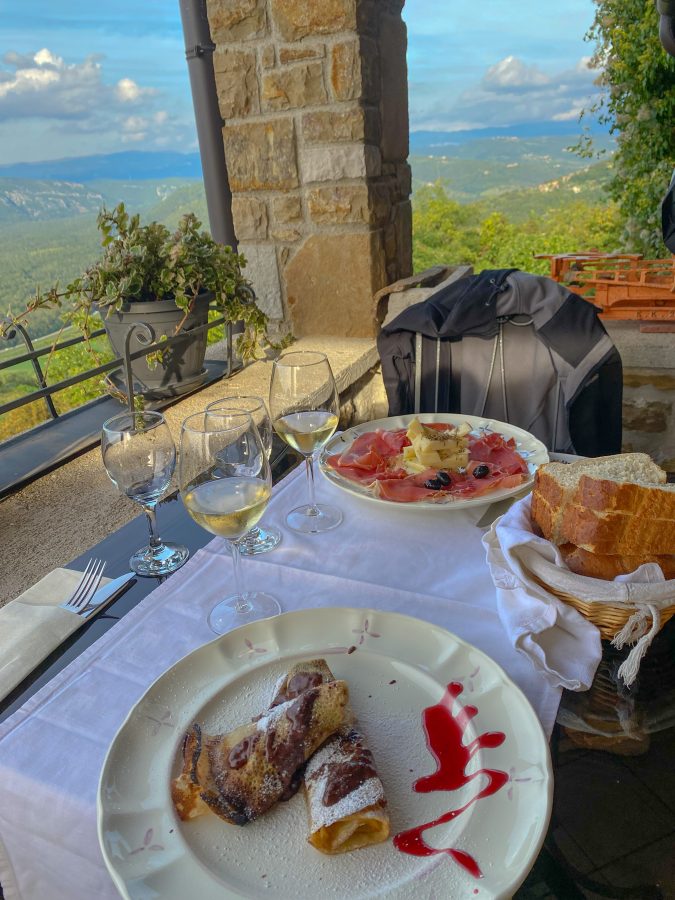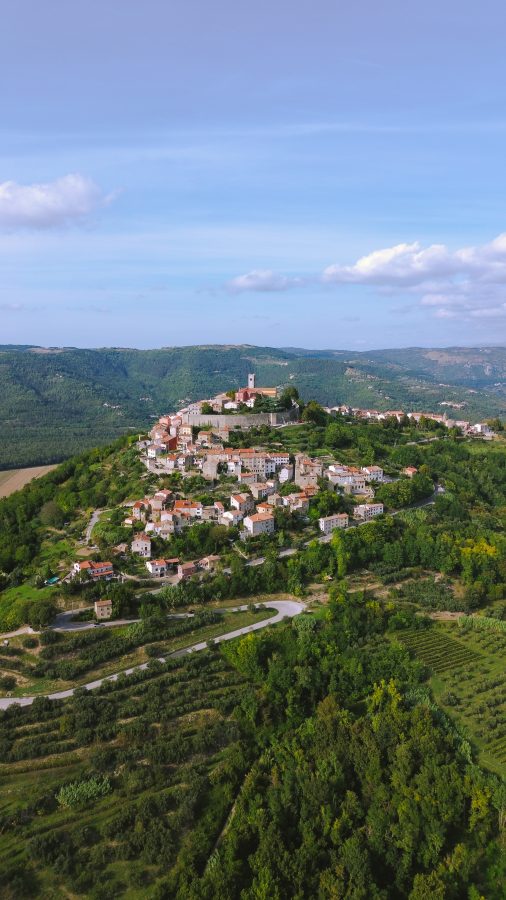The town is located at a height of 270 m in a fortress, on a hill, offering a beautiful panoramic view of the surrounding landscape, including vineyards, forests and the valley of the Mirna River.
A fairytale medieval town on a hill, Motovun has become a very attractive and popular tourist destination. After each of our trips to Motovun, we are always happy to visit it again. Motovun is full of natural sights and natural beauties.
This small town is located on the northern part of the Istrian peninsula, near the town of Pazin. The city has a rich history that stretches back to Roman times. Its position on top of a hill made it strategically important. Over the past centuries, it has passed through the hands of various rulers and empires. The historic core of Motovun is characterized by well-preserved medieval architecture. The town is surrounded by strong walls and fortifications from the 13th century and its cobbled streets are lined with ancient buildings, including churches, houses and town shops.
There are 26 protected cultural monuments in the old town center of Motovun and they are on the UNESCO World Heritage list.
In the past, although states and rulers often changed over the city, Motovun was always the center. The most famous ledenge of Motovun and beliefs say that it is located at the source of energy where three dragon furrows cross and that everyone is always in a good mood here.
River Mirna
The river Mirna, the longest river of the Istrian peninsula flows at the foot of this hill rich in vegetation. It got its name from its calmness, as the word itself says. The river flows from the Kotli source through the Motovun forest and flows into the Adriatic Sea. Vineyards and olive groves spread around the Mirna River. Vineyards and olive groves spread around the Mirna River. This is why they have a very successful production and preparation of the best quality wines of Istria. Malvasia and Muscat are one of the most famous wines in this area. Absolutely do not forget to taste!





Motovun forest, home of truffles
The Motovun forest is known as the right place for truffle hunting. Truffles are highly valued and aromatic mushrooms that grow underground along the roots of certain trees, especially oak and hazelnut trees. The forest soil and climatic conditions are ideal for the growth of truffles, and it is also known for the production of black and white truffles. Visitors to Motovun and the surrounding area often have the opportunity to go on tours in search of truffles. These tours usually include experienced truffle hunters and their trained dogs, who are skilled at locating truffles beneath the forest floor. The Motovun forest is not only a natural treasure, but also an important part of the cultural and culinary heritage of this region. This adds to the charm of Motovun as a tourist destination, attracting visitors who want to explore its natural beauty and enjoy the unique flavors of truffle dishes.
You can read more about truffles here;https://www.istriabooker.com/en/blog/you-must-have-heard-about-istrian-truffles-every-gourmet-wants-them-on-their-plate/



During the Austro-Hungarian Monarchy, the Motovun forest was planted with trees to supply the shipyard with construction wood. Today, it is the largest white truffle landscape finding.
Parezana
Parezana was a historic narrow-gauge railway that operated on the Istrian peninsula in Croatia and parts of Slovenia and Italy during the late 19th and early 20th centuries. The Parenzana railway was originally built at the end of the 19th century as a narrow-gauge (76 cm) railway. It connected the cities and regions of Istria, which was then part of Austria-Hungary.
It was built primarily for economic reasons to transport agricultural products, especially wine and olive oil, as well as passengers. The Parenzana railway is known for its picturesque route, which takes passengers through rolling hills, vineyards, olive groves and charming rural landscapes. It offered a beautiful view of the Istrian landscape, which made it a popular route for tourists and travelers. The Parenzana railway operated for several decades, but with the advent of road traffic, it gradually lost its economic viability.
The railway stopped operating in the middle of the 20th century, and the last train ran in 1935. The rails were dismantled and the railway was abandoned.
Dvoja city gates

In Motovun, a medieval town on the Istrian peninsula in Croatia, there are two main city gates, known as the “Dvoja city gates.” These gates represent the main entrances to the old town and are part of its rich history and fortification system. They are located at the southern entrance to Motovun and are often the first thing visitors see when entering the old town. This door often serves as a symbol of the city.
Photogallery of the city of Motovun






